
The Tamil people, also known as Tamilar, Tamilians, or simply Tamils, are a Dravidian ethnolinguistic group who natively speak the Tamil language and trace their ancestry mainly to India's southern state of Tamil Nadu, the union territory of Puducherry, and to Sri Lanka. The Tamil language is one of the world's longest-surviving classical languages, with over 2000 years of Tamil literature, including the Sangam poems, which were composed between 300 BCE and 300 CE. People who speak Tamil as their mother tongue and are born in Tamil clans are considered Tamils.

Uttama, also known as Madhurantaka, was a Chola Emperor who ruled from 970 CE to 985 CE in present-day Tamil Nadu, India. According to Tiruvalangadu plates of Rajendra Chola, Madhurantaka Uttama's reign is placed after Aditya II. The latter may have been a co-regent of Parantaka II and seems to have died before he could formally ascend the throne. Uttama was the cousin of Parantaka II and was the son of the illustrious Sembiyan Mahadevi and Gandaraditya.
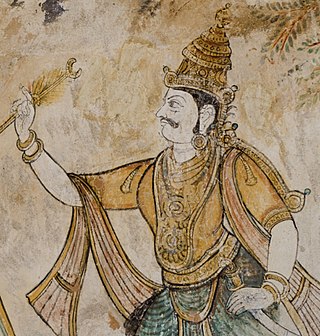
Rajaraja I, also known as Raja Raja the Great, was a Chola emperor who reigned from 985 CE to 1014 CE. He is known for his conquests of Southern India and parts of Sri Lanka, and increasing Chola influence across the Indian Ocean.

Kulottunga I also spelt Kulothunga, born Rajendra Chalukya, was a Chola Emperor who reigned from 1070 CE to 1122 CE succeeding his cousin Athirajendra Chola. He also served as the Eastern Chalukya monarch from 1061 CE to 1118 CE, succeeding his father Rajaraja Narendra. He is related to the Chola dynasty through his mother's side and the Eastern Chalukyas through his father's side. His mother, Ammangaidevi, was a Chola princess and the daughter of emperor Rajendra Chola I. His father was king Rajaraja Narendra of the Eastern Chalukya dynasty who was the nephew of Rajendra Chola I and maternal grandson of Rajaraja Chola I. According to historian Sailendra Nath Sen, his accession marked the beginning of a new era and ushered in a period of internal peace and benevolent administration.

Aditya II, also known as Aditha II or Adithya Karikalan, was a Chola prince who lived in the 10th century in India. He was born in Tirukoilur and was the eldest son of Parantaka Chola II. He was the elder brother of Rajaraja Chola I and Kundavai. He was called Virapandiyan Thalai Konda Koparakesari Varman Karikalan.

Kongu Nadu, also known by various names such as Kongu Mandalam and Kongu belt, is a geographical region comprising present day parts of western Tamil Nadu, southeastern Karnataka and eastern Kerala. In the ancient Tamilakam, it was the seat of the Chera kings, bounded on the east by Tondai Nadu, on the south-east by Chola Nadu and on the south by Pandya Nadu regions.
Arinjaya Chola was a ruler of the Chola kingdom. He was the third son of Parantaka I and the younger brother of Gandaraditya Chola, whom he is thought to have succeeded in about 956. Arinjaya Chola was succeeded by his son Sundara Chola as Madurantaka Uttama Chola was not old enough to ascend the throne. Arinjaya seems to have ruled for a very short time.
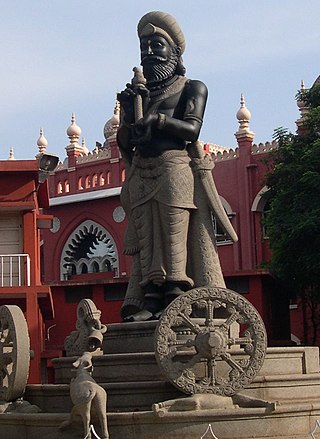
Ellalan was a member of the Tamil Chola dynasty in Southern India, also known as "Manu Needhi Cholan", who upon capturing the throne became king of the Anuradhapura Kingdom, in present-day Sri Lanka, from 205 BCE to 161 BCE.

Rajendra II often referred to as Rajendradeva Chola was a Chola emperor who reigned from 1052 CE to 1064 CE. Rajendra II succeeded his brother Rajadhiraja I after his death at the Battle of Koppam. Rajendra had served as a Co-regent under his brother from 1044 CE to 1052 CE. When he acceded the throne, the Chola Empire was at its peak stretching from Southern India to Vengai(Bengal) to parts of Southeast Asia. Rajendra has maintained the territories of his predecessor. During his reign, the Chola Empire was prosperous and had a large influence in trade throughout the Indian Ocean.
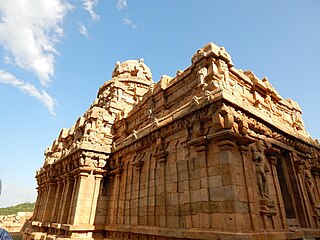
Narthamalai, a cluster of small hills, is 25 km from Trichy on the Trichy-Pudukottai highway in the state of Tamil Nadu, India. Here can be seen some of the oldest rock cut cave temples, as well as the longest rock-cut edicts, similar to Asokan edicts and extremely rare in the south of India. The town houses Vijayalaya Choleeswaram built during the 9th century. The two rock-cut temples are classic examples of how temple architecture styles were fusing in different parts of the country.
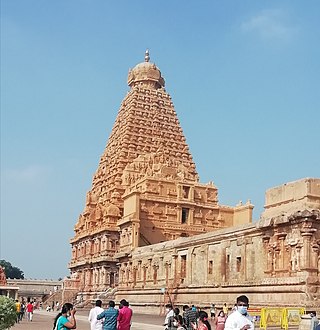
Brihadishvara Temple, called Rajarajesvaram by its builder, and known locally as Thanjai Periya Kovil and Peruvudaiyar Kovil, is a Shaivite Hindu temple built in a Chola architectural style located on the south bank of the Cauvery river in Thanjavur, Tamil Nadu, India. It is one of the largest Hindu temples and an exemplar of Tamil architecture. It is also called Dakshina Meru. Built by Chola emperor Rajaraja I between 1003 and 1010 CE, the temple is a part of the UNESCO World Heritage Site known as the "Great Living Chola Temples", along with the Chola-era Gangaikonda Cholapuram temple and Airavatesvara temple, which are about 70 kilometres (43 mi) and 40 kilometres (25 mi) to its northeast respectively.

Atiyamāṉ were a royal Velir dynasty. These king-chiefs ruled from their capital Tagadur from at least the 3rd century BCE. The royal house was one of the four kingdoms of Tamilakam, ruling parts of the Kongu Nadu. They were surrounded by the Cheras to the west and the Pandyas and Cholas to the east.

Ramachandran Nagaswamy was an Indian historian, archaeologist and epigraphist who was known for his work on temple inscriptions and art history of Tamil Nadu. He was an authority on Chola bronzes.
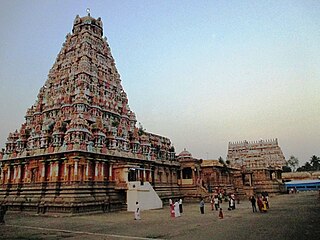
The Kampaheswarar Temple or kampa-hara-ishvarar is a Hindu temple dedicated to the god Shiva. It is situated in Thirubuvanam, a village in Thanjavur district in the South Indian State of Tamil Nadu, on the Mayiladuthurai-Kumbakonam road. Shiva is worshiped as "Kampahareswarar" as he removed the quaking of a king who was being haunted by a Brahmarakshasa. It was built by Kulothunga Chola III and is considered the last of the four masterpieces built during the Medieval Chola era.
Perumukkal is a small village in the Tindivanam municipality of the Villuppuram district in the Indian state of Tamil Nadu. The major occupation of its residents is agriculture. In 2011 it had a population of 3,000.

Tamil Nadu State Department of Archaeology (TNSDA) is the archaeology department of the Government of Tamil Nadu. Founded in 1961, the department is headed by an Indian Administrative Service (IAS) officer with the designation Commissioner for Archaeology and conducts archaeological excavations in the state of Tamil Nadu.

Vijayalaya Choleeswaram in Narthamalai, a panchayat town in Pudukottai district in the South Indian state of Tamil Nadu, India, is a temple dedicated to the Hindu god Shiva, Vishnu and houses the 8th century Jaina Abode. The temple is considered one of the oldest stone temples in South India. The other portions of Narthamalai houses the 8th century Jaina Abode, the Aluruttimalai Jain Caves. The Temple is Constructed in the Dravida style and rock cut architecture, the temple is believed to have been built during the 9th century by Mutharaiyar dynasty kings, the cardinals of Pallavas, with later expansion from the Cholas. The rock-cut architecture is an early example of Cholan Art, continuing the tradition of the Pallavas.

Kunnandarkoil Cave Temple in Kunnandarkoil, a village in Pudukottai district in the South Indian state of Tamil Nadu, is dedicated to the Hindu god Shiva. Constructed in Rock-cut architecture, the temple is believed to have been built during the 8th century by Muttaraiyar kings, the cardinals of Pallavas, with later expansion from the Vijayanagar Empire. The rock-cut architecture in the temple is a specimen of the late Pallava Art and an early example of Chola Art. The temple has various inscriptions from Cholas, Chalukyas, Pandyas and Vijayanagar Empire. The temple is considered one of the oldest stone temples in South India. The temple is maintained and administered by Department of Archaeological Survey of India as a protected monument.
The Mutharaiyar was a south Indian dynasty that governed the Thanjavur, Trichy and Pudukottai regions between 600 and 850 CE.

This is a list of archaeological artefacts and epigraphs which have Tamil inscriptions. Of the approximately 100,000 inscriptions found by the Archaeological Survey of India in India, about 60,000 were in Tamil Nadu















